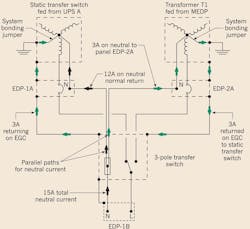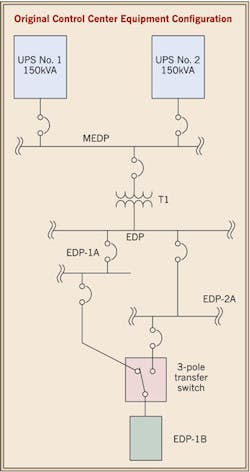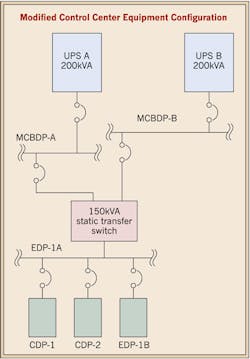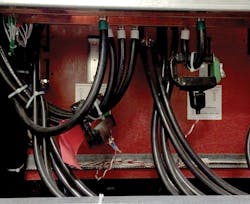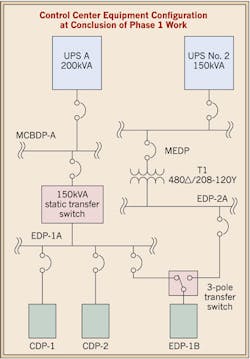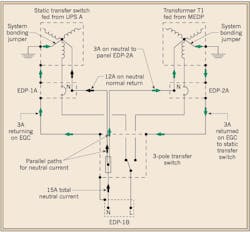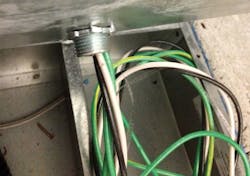The Case of the Unwanted Ground Current
Hearing the expression “ground current” often causes stress and frustration for many electrical contractors and engineers. Few things in the power industry are as important and as misunderstood as ground current. Many don’t understand the details of system grounding and bonding, the differences between the two, or how they really work. When you install equipment and systems in accordance with NEC requirements, typically everything works as it should. But when it doesn’t, you’re often left searching for answers.
Case study
The following scenario happened to a large electric utility when upgrading its uninterruptible power supply (UPS) system and associated distribution wiring system as part of a control center upgrade. Part way through the project, it began experiencing high ground current alarms on a new static transfer switch (STS). Finding the source of the problem proved quite challenging.
The utility’s original control center included two 150kVA/120kW UPS units (with 480VAC outputs) configured as a parallel redundant system (Fig. 1). The system was replaced by two 200kVA/200kW modular UPS systems and a 150kVA STS with a reconfigured distribution wiring system. With the new system, UPS System ‘A’ feeds ‘A’ power supplies while UPS System ‘B’ feeds ‘B’ power supplies in the dual power supply IT equipment arrangement. All single-corded equipment is powered by the STS (Fig. 2).
The retrofit was completed in several phases, which allowed operations to continue uninterrupted. Phase 1 included removing UPS System 1 while all existing loads were supported by UPS System 2 and installing new UPS system ‘A’ and the STS. Several existing load panels were moved to the STS, and several new panels were installed.
At the conclusion of Phase 1, UPS System ‘A’ and the STS were factory started and commissioned. But, as the contractor continued to add more new panelboards, “High Output Ground Current” alarms began occurring on the STS (Fig. 3). At this point, a service call was placed to the STS manufacturer. It recommended the ground sensing circuit be calibrated, and dispatched a technician under a warranty service call.
Troubleshooting efforts
When the technician arrived to perform the calibration, approximately 10A were measured on the system bonding jumper, commonly called the “neutral to ground bond” (N-G bond). The STS uses a current transformer positioned around the bonding jumper (Photo 1) to monitor current on any load panel’s equipment grounding conductors (EGCs), commonly referred to as the “ground.” Any current on ground would return through the bonding jumper to the grounded conductor, commonly called “neutral,” and be classified as objectionable ground current.
The STS manufacturer determined the ground current sensing circuit was functioning properly and recommended the source of the current be found or the design engineer contacted to discuss an acceptable value. Subsequent conversations between the design engineer, building owner, and general contractor concluded that work on the project should not continue until the cause of the ground current was found and corrected. Their decision was based primarily on the requirements set forth in Sec. 250.6 [Objectionable Ground Current] of the NEC. The two concerns expressed by the design engineer and the building owner were the existing ground current on the STS and the possibility of additional ground current when the remaining panels were added.
One of the most common causes of ground current is non-compliant neutral to ground bonds. The NEC only allows for neutral to ground bonds in certain cases, including:
• Services entrances [Sec. 250.24(B)].
• Special cases, in accordance with Sec. 250.142.
• Separately derived sources defined by Art. 100 as a premise wiring system whose power is derived from a source of electric energy or equipment other than a service. Such systems have no direct connection from circuit conductors of one system to circuit conductors of another system, other than connections through the earth, metal enclosures, metallic raceways, or equipment grounding conductors.
Since this was not a service entrance or a special case under Sec. 250.142, the electrical engineer recommended that the electrical contractor review all load panels for non-compliant neutral to ground bonds. During the review, the electrical contractor also recorded the current on each panel’s main EGC. When no immediate cause was found for the ground current, our company was contacted to assist in pinpointing the problem.
Power quality investigation and analysis
Our firm’s first step was to understand the installation as it was configured at the end of Phase 1. Where in the system were bonding jumpers installed and N-G bonds required, and were there any in the system that were not allowed? After a detailed site walk-through inspection and review of the drawings, it was determined the only place in the existing installation that an N-G bond would be allowed was at the STS.
The STS uses two isolation transformers, one for each source, to step down the 480V input from the UPS systems to 208/120V for distribution. The transformer arrangement would make the STS a separately derived system, per the NEC. A system bonding jumper (i.e., N-G bond) would be required at this location per Sec. 250.30. This is the only separately derived source in this section of the distribution system; therefore, no panels downstream of the STS should have bonding jumpers.
We then used the data collected by the electrical contractor to begin a systematic approach to locate the objectionable current. All panels were once again checked for non-compliant N-G bonds by visual inspection and millivolt readings taken between the neutral and ground. This work confirmed there were no illegal bonds in the new or existing panels. Current on each panel’s main EGCs were also measured and compared with the data provided by the electrical contractor.
The next step was to choose a panel and begin isolating the cause of the unwanted ground current. In the original installation, EDP-1A and EDP-2A each fed one source of a transfer switch. EDP-2A was not being used after the completion of Phase 1, but would be returned to service at the completion of Phase 2 of the overall project. Since it was not supporting any critical load, it made for a convenient place to start.
While inspecting panel EDP-2A, 3A of current was measured on the neutral and ground conductors from the transfer switch. No load was being supported by panel EDP-2A; therefore, no current should have been present on any conductors.
During an inspection of the transfer switch, the neutral conductor feeding Panel EDP-1B measured 15A. But the neutral returning to Panel EDP-1A only measured 12A. The current returning on the neutral of EDP-2A measured 3A. A current of 3A was measured on both the EGCs of feeds from Panel EDP-1A and EDP-2A (Fig. 4).
Panel EDP-1B was only powered from EDP-1A, so no current should have been present on any conductors in EDP-2A. The neutral conductor in panel EDP-2A was removed, which isolated all phase and neutral conductors from the transfer switch. This removed the parallel path for the neutral current in panel EDP-1B. All 15A of neutral current was now being carried by the neutral of panel EDP-1A, eliminating ground current on panel EDP-1A and EDP-2A. This reduced the total ground current on the STS from 10A to 7A.
Before the installation of the parallel 150kVA UPS systems, the existing installation used a 3-pole transfer switch to feed panel EDP-1B, which supported telephone operations. This provided redundant power sources for the telephone system. Source one of the transfer switch was from EDP-1A and source 2 from EDP-2A. Both panel EDP-1A and EDP-2A were fed from the parallel UPS systems output wiring arrangement during a previous upgrade (Fig. 1 on page 14).
Panels EDP-1A and EDP-2A were existing panels, and their neutrals were bonded to the neutral lugs in the transfer switch. With the re-feed of panel EDP-1A from the new STS, the parallel paths were from different sources. For current to return to the source of EDP-1A, current on the neutral conductor of EDP-2A could only return on the equipment ground conductor (see Fig. 4 for details).
It should be noted that the ground current measured on panel EDP-1A and EDP-2A was the same current. Finding and correcting the parallel paths in the transfer switch eliminated the ground current in panel EDP-1A and reduced the ground current on the STS to 7A.
The re-use of the existing 3-pole transfer switch was incorrect for the system configuration. It allowed parallel paths for neutral current to be shared by both EDP-1A and EDP-2A. There was no ground current monitoring on the original system to identify this issue. In addition, the neutrals returned to the same source (transformer T1), which reduced the likelihood of ground current during normal operation.
It was recommended the STS be removed from service as the new infrastructure already provided redundant sources of UPS power to panel EDP-1B. An alternate option would have been to install a 4-pole transfer switch to prevent parallel paths for current on the neutral wire and comply with the NEC. The owner decided the transfer switch was not needed, and removed it from service.
The correction of the parallel neutrals in the transfer switch reduced the ground current on the STS but didn’t eliminate it completely. Ground current still existed on the main EGC of panels CDP-1 and CDP-2. A clamp-on current meter was used to measure the ground conductor on each circuit to isolate the specific circuits causing the objectionable current. Circuit 21 in panel CDP-1 and circuit 17 in panel CDP-2 were each found to have around 3.5A of current.
A visual inspection of the junction boxes and receptacles of each circuit was completed. During the inspection, insulation on the neutral conductor was found to have been cut as it transitioned from a metal pull box to the metal-clad cable. This cut bonded the neutral to the metal box, creating an N-G bond (Photo 2). This bond allowed parallel paths for current on the neutral and ground conductors. The wire in both circuits was replaced, which reduced ground current to zero.
Lessons learned
Several factors contributed to objectionable ground current on this installation. The original installation of the transfer switch didn’t meet Sec. 250.6 requirements once the new system configuration was implemented, which added a new transformer. This didn’t show up until the retrofit was completed, and a system with ground monitoring capability was installed. Limited experience and knowledge of system grounding and bonding, along with changes with the existing site electrical installation, made it hard for contractors to find and eliminate the cause of the objectionable current.
In addition, the specification required all new 20A branch circuits be installed with 10 AWG solid wire and an isolated ground. The addition of the isolated ground, the larger solid wire, and poor workmanship during installation all resulted in conductors being strained during the installation and two being damaged. This resulted in N-G bonds.
Many times, finding and eliminating ground current is as simple as locating a non-compliant N-G bond in a branch panel and removing it. Other times, it can prove quite elusive, resulting in days or even weeks of searching through a facility. If a retrofit is being completed and operations must continue, it is critical that care be taken during the design process to understand how the temporary installation will interact with the existing infrastructure — and how the system will change during the process. This can help to prevent not only delays in construction, but also the dangers of objectionable ground current.
DeLauter, P.E. is an engineer at Static Power Conversion Services, Inc. in Columbia, Md. He can be reached at [email protected].
